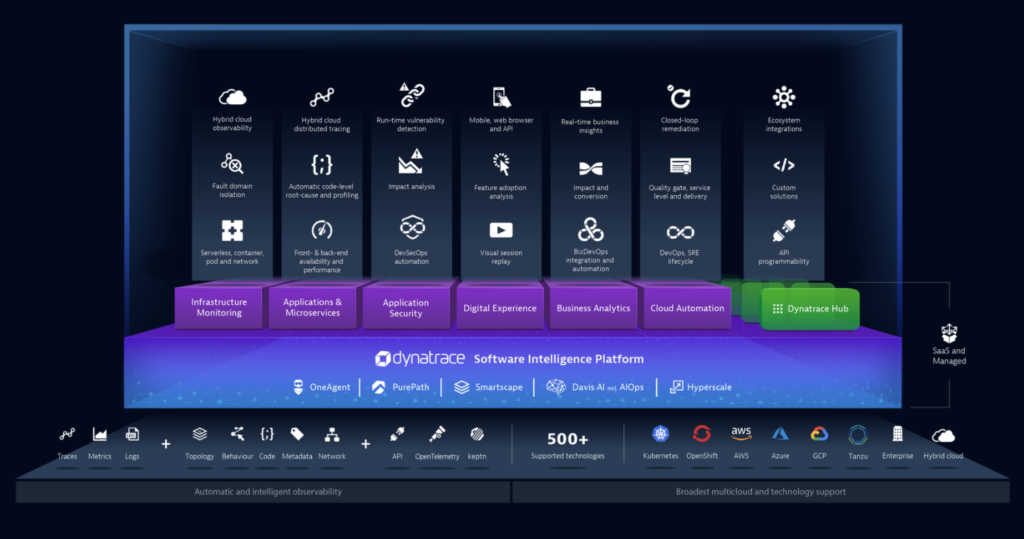
About Dynatrace
Dynatrace as we know it today was spun out from Compuware’s application performance management (APM) business unit in 2014 after Compuware was acquired by Thoma Bravo, LLC. Initially founded as dynaTrace Software GmbH in early 2005 and based out of Linz, Austria, the company was acquired by Compuware in 2011. Dynatrace (NYSE:DT) completed its IPO on August 1, 2019](https://ir.dynatrace.com/news-events/press-releases/detail/157/dynatrace-announces-closing-of-initial-public-offering-and).
Headquartered in Waltham, MA, Dynatrace has 50 offices around the world with an especially strong presence in EMEA. Current leadership includes John Van Siclen (CEO), Bernd Greifeneder (CTO and an initial founder), Kevin Burns (CFO), and Mike Maciag (CMO).
The Dynatrace elevator pitch (per Dynatrace):
Dynatrace provides software intelligence to simplify cloud complexity and accelerate digital transformation. With advanced observability, AI and complete automation, our all-in-one platform provides answers, not just data, about the performance of applications, the underlying infrastructure, and the experience of all users.
As we have seen with APM vendors across the industry, Dynatrace has reframed its offerings around the concept of observability, arguing that its Software Intelligence Platform “advances observability with contextual information, artification intelligence, and automation.” The company also recently announced the addition of new application security capabilities to its platform.
Size
- 2200+ employees
- 2600 customers
- Customers in 70+ countries; geographical sales breakdown: North America (56%), EMEA (31%), Asia Pacific (11%), Latin America (2%)
- Q2 2021 earnings (for the quarter ending September 30, 2020):
- Total Revenue: $168.6 million
- Total ARR: $636.1 million
Products
Dynatrace offers what it calls an “all-in-one” Software Intelligence Platform with “modules” designed for the following use cases:
- Application & Microservices (formerly APM)
- Application Security
- Business Analytics
- Cloud Automation
- Digital Experience
- Infrastructure Monitoring
The platform is built on technologies including OneAgent (data collection), PurePath (distributed tracing and code analysis), Smartscape (environment visualization), and Davis (open AI engine). Platform access is priced via subscription, with full-stack monitoring, infrastructure monitoring, and digital experience monitoring plans offering different combinations of the available modules; a free trial is available.
A diagram of the current iteration of the Dynatrace Software Intelligence Platform, via the company’s Platform Overview page:
Dynatrace also supports open source projects such as OpenTelemetry, though it positions its own agents as offering a richer set of data about systems performance.
Another notable open source play is with its own project Keptn, a control plane for continuous delivery. We’re increasingly seeing a convergence of CI/CD tools and observability tools, as pipelines become production environments, and testing moves into production. We need to be able to deploy changes, and roll them back, with full observability, for modern software engineering best practices such as Progressive Delivery.
GTM
Dynatrace targets enterprises via both direct sales and partners, with a solid list of marquee customers in categories including IT (SAP, Citrix), retail and ecommerce (Kroger, eBay), and financial services (KeyBank, Virgin Money). As one would expect from any vendor targeting the enterprise, Dynatrace also offers two tiers of support and enablement, a number of service options, and both on demand learning courses as well as instructor-led training.
Competitive Landscape
In the APM space, Dynatrace competes with the likes of Cisco AppDynamics, Datadog, New Relic, and Wavefront by VMware. However, as the conversations in this space increasingly shift towards observability, Dynatrace will likely find itself competing for mindshare among forward-thinking cloud native shops with observability-native organizations like Honeycomb.io. It will also run into greater competition with the likes of Splunk (which is also making stronger motions towards the APM space with recent acquisitions), SumoLogic, and Elastic, as log management vendors also retool to pursue the observability market opportunity.
With respect to the “3 pillars of observability,” the other space to watch is distributed tracing for microservices. Lightstep has made much of the running there from a recent mindshare perspective, after the emergence of tools such as Jaeger and Zipkin. But Dynatrace can justifiably claim to have strong roots and mature technology for tracing and visualization (the clue is in the company name).
The cloud hyperscale players are also not ignoring observability. AWS is investing heavily there, and is beginning to even offer tools for on premise monitoring. Google Cloud acquired Stackdriver in 2014 and has now rolled the functionality into Google Cloud Operations Suite.
Regarding Dynatrace’s recently announced Application Security module: application security is a natural adjacent market for observability. Troubleshooting is just as important for security as for performance monitoring or other functional areas. Application remediation for security is a hot market, which should become even hotter given the SolarWinds debacle. And while Dynatrace is building its own application security features, it has also wisely included in its initial incarnation a built-in integration with Snyk, the leading DevSecOps player – which offers tools for analyzing dependencies in code before and during deployment.
Disclosure: Dynatrace is a RedMonk client, but this is an independent piece of research that has not been commissioned by the client. AWS, Google Cloud, Honeycomb, New Relic, Snyk, Splunk, and VMware are also RedMonk clients.
Update: an earlier version of this post erroneously listed 2005 as the year Compuware acquired dynaTrace.


No Comments